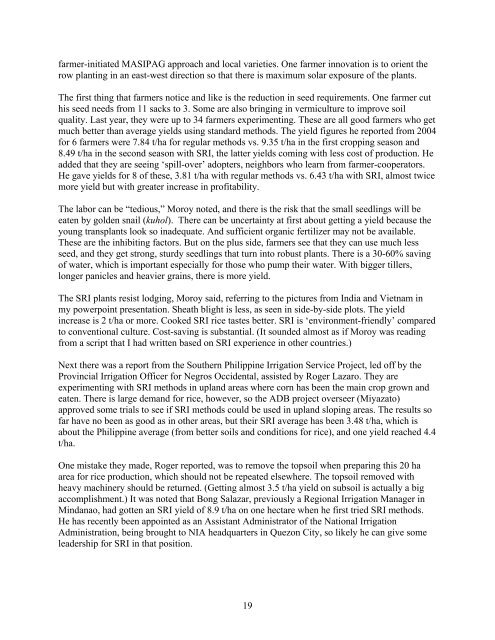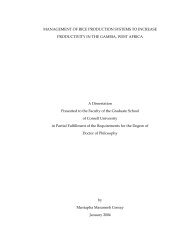report on a visit to the philippines to review sri progress
report on a visit to the philippines to review sri progress
report on a visit to the philippines to review sri progress
You also want an ePaper? Increase the reach of your titles
YUMPU automatically turns print PDFs into web optimized ePapers that Google loves.
farmer-initiated MASIPAG approach and local varieties. One farmer innovati<strong>on</strong> is <strong>to</strong> orient <strong>the</strong><br />
row planting in an east-west directi<strong>on</strong> so that <strong>the</strong>re is maximum solar exposure of <strong>the</strong> plants.<br />
The first thing that farmers notice and like is <strong>the</strong> reducti<strong>on</strong> in seed requirements. One farmer cut<br />
his seed needs from 11 sacks <strong>to</strong> 3. Some are also bringing in vermiculture <strong>to</strong> improve soil<br />
quality. Last year, <strong>the</strong>y were up <strong>to</strong> 34 farmers experimenting. These are all good farmers who get<br />
much better than average yields using standard methods. The yield figures he <str<strong>on</strong>g>report</str<strong>on</strong>g>ed from 2004<br />
for 6 farmers were 7.84 t/ha for regular methods vs. 9.35 t/ha in <strong>the</strong> first cropping seas<strong>on</strong> and<br />
8.49 t/ha in <strong>the</strong> sec<strong>on</strong>d seas<strong>on</strong> with SRI, <strong>the</strong> latter yields coming with less cost of producti<strong>on</strong>. He<br />
added that <strong>the</strong>y are seeing ‘spill-over’ adopters, neighbors who learn from farmer-coopera<strong>to</strong>rs.<br />
He gave yields for 8 of <strong>the</strong>se, 3.81 t/ha with regular methods vs. 6.43 t/ha with SRI, almost twice<br />
more yield but with greater increase in profitability.<br />
The labor can be “tedious,” Moroy noted, and <strong>the</strong>re is <strong>the</strong> risk that <strong>the</strong> small seedlings will be<br />
eaten by golden snail (kuhol). There can be uncertainty at first about getting a yield because <strong>the</strong><br />
young transplants look so inadequate. And sufficient organic fertilizer may not be available.<br />
These are <strong>the</strong> inhibiting fac<strong>to</strong>rs. But <strong>on</strong> <strong>the</strong> plus side, farmers see that <strong>the</strong>y can use much less<br />
seed, and <strong>the</strong>y get str<strong>on</strong>g, sturdy seedlings that turn in<strong>to</strong> robust plants. There is a 30-60% saving<br />
of water, which is important especially for those who pump <strong>the</strong>ir water. With bigger tillers,<br />
l<strong>on</strong>ger panicles and heavier grains, <strong>the</strong>re is more yield.<br />
The SRI plants resist lodging, Moroy said, referring <strong>to</strong> <strong>the</strong> pictures from India and Vietnam in<br />
my powerpoint presentati<strong>on</strong>. Sheath blight is less, as seen in side-by-side plots. The yield<br />
increase is 2 t/ha or more. Cooked SRI rice tastes better. SRI is ‘envir<strong>on</strong>ment-friendly’ compared<br />
<strong>to</strong> c<strong>on</strong>venti<strong>on</strong>al culture. Cost-saving is substantial. (It sounded almost as if Moroy was reading<br />
from a script that I had written based <strong>on</strong> SRI experience in o<strong>the</strong>r countries.)<br />
Next <strong>the</strong>re was a <str<strong>on</strong>g>report</str<strong>on</strong>g> from <strong>the</strong> Sou<strong>the</strong>rn Philippine Irrigati<strong>on</strong> Service Project, led off by <strong>the</strong><br />
Provincial Irrigati<strong>on</strong> Officer for Negros Occidental, assisted by Roger Lazaro. They are<br />
experimenting with SRI methods in upland areas where corn has been <strong>the</strong> main crop grown and<br />
eaten. There is large demand for rice, however, so <strong>the</strong> ADB project overseer (Miyaza<strong>to</strong>)<br />
approved some trials <strong>to</strong> see if SRI methods could be used in upland sloping areas. The results so<br />
far have no been as good as in o<strong>the</strong>r areas, but <strong>the</strong>ir SRI average has been 3.48 t/ha, which is<br />
about <strong>the</strong> Philippine average (from better soils and c<strong>on</strong>diti<strong>on</strong>s for rice), and <strong>on</strong>e yield reached 4.4<br />
t/ha.<br />
One mistake <strong>the</strong>y made, Roger <str<strong>on</strong>g>report</str<strong>on</strong>g>ed, was <strong>to</strong> remove <strong>the</strong> <strong>to</strong>psoil when preparing this 20 ha<br />
area for rice producti<strong>on</strong>, which should not be repeated elsewhere. The <strong>to</strong>psoil removed with<br />
heavy machinery should be returned. (Getting almost 3.5 t/ha yield <strong>on</strong> subsoil is actually a big<br />
accomplishment.) It was noted that B<strong>on</strong>g Salazar, previously a Regi<strong>on</strong>al Irrigati<strong>on</strong> Manager in<br />
Mindanao, had gotten an SRI yield of 8.9 t/ha <strong>on</strong> <strong>on</strong>e hectare when he first tried SRI methods.<br />
He has recently been appointed as an Assistant Administra<strong>to</strong>r of <strong>the</strong> Nati<strong>on</strong>al Irrigati<strong>on</strong><br />
Administrati<strong>on</strong>, being brought <strong>to</strong> NIA headquarters in Quez<strong>on</strong> City, so likely he can give some<br />
leadership for SRI in that positi<strong>on</strong>.<br />
19

















